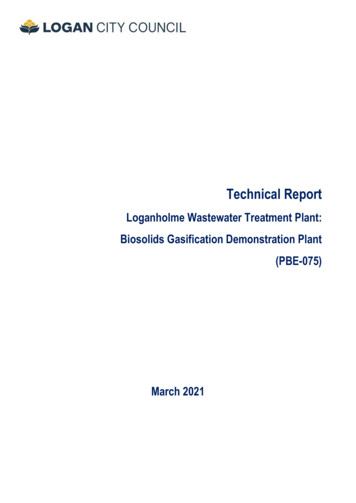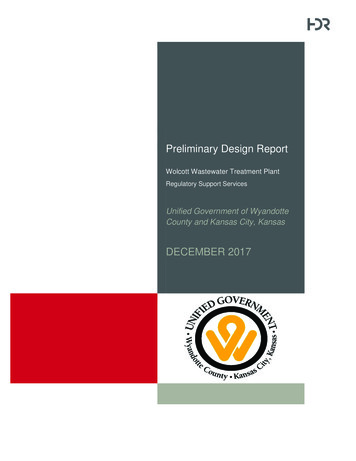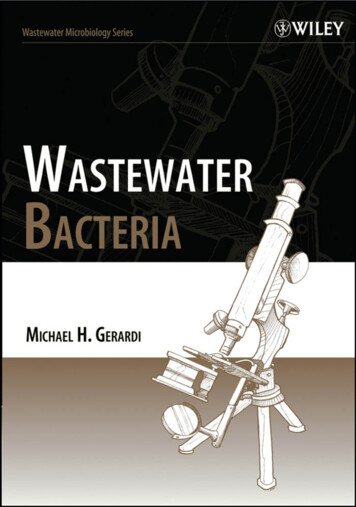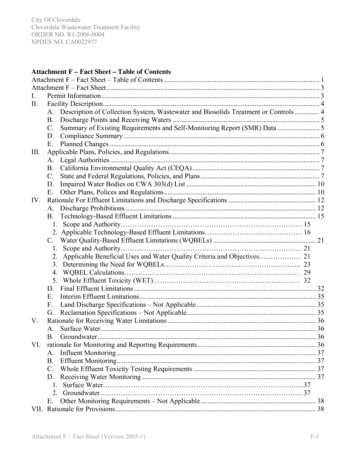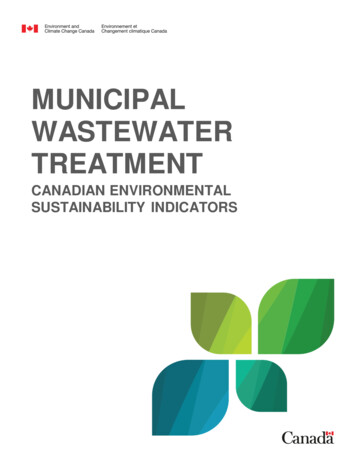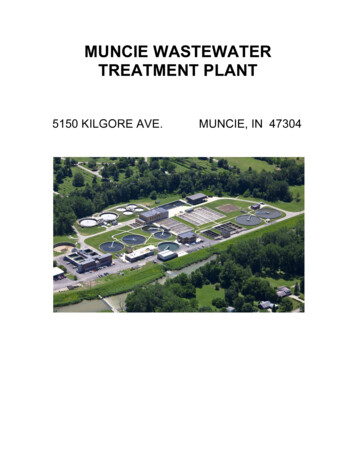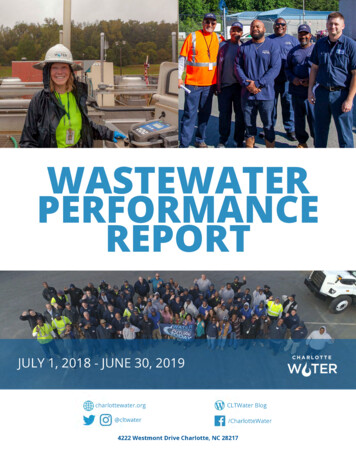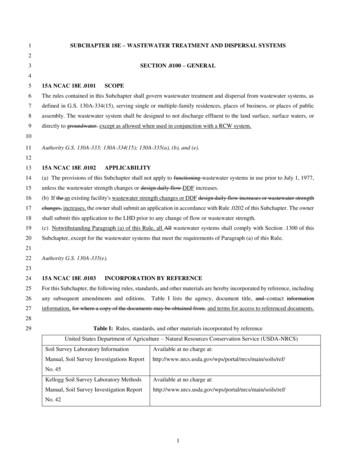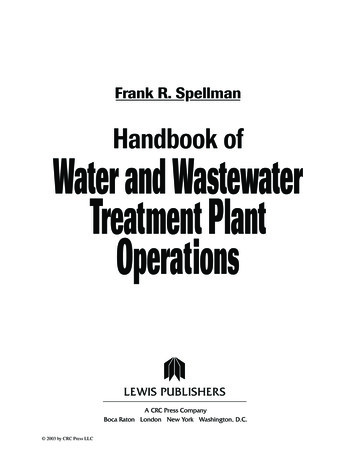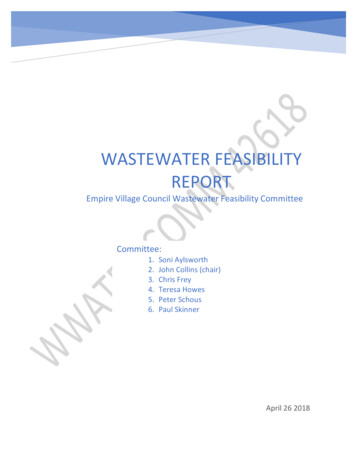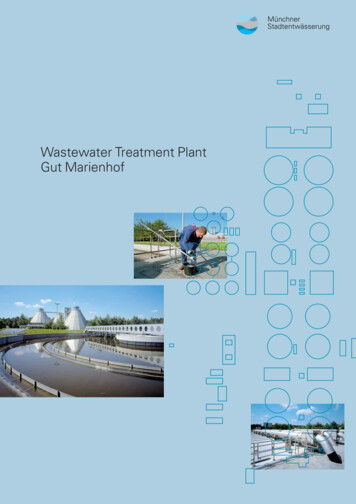
Transcription
Wastewater Treatment PlantGut Marienhof
Out of sight, out of mind:Who thinks about the water that disappears down the drain after washingup, doing the dishes or the laundry?Only a few. And only a minority ofthese few ask for technical details onhow to prevent the wastewater ofMunich from polluting the environment.This is a pity, because the answerswould give them reason to be proudof their city and its exemplary conceptfor wastewater management. Let’sconsider the Wastewater TreatmentPlant Gut Marienhof, in which this concept comes to life.Munich s Second Wastewater Treatment Plant2 400 Kilometres of Sewer NetworkTwo for 1.5 MillionThe Isar River, a Sensitive Receiving WaterLandscape and ArchitectureArchitecture and OperationThe Treatment ConceptLittle Helpers in the PlantWastewater DisinfectionFlow Diagram of the Wastewater Treatment Plant
Munich’s Second Wastewater Treatment PlantThe story of the Wastewater TreatmentPlant Gut Marienhof almost endedbefore it actually began. The first planswere made in 1940, but were shelvedbecause the Second World War andthe postwar period set other priorities.However, Munich grew – and with itthe amount of wastewater. By the earlySeventies environmental consciousness had grown and appropriate legalrequirements were made. In 1972 theold project was ready for realisation.Regional planning between 1972 and1974 decided on the plant’s final location ten kilometres north of the MunichCity Limit in Dietersheim, which is adistrict of the Community of Eching.The advantages of this location are thatthe wastewater can be directed therein free flow and that the receivingwater, the Isar River, is nearby. Zoningand water rights procedures definedthe design and performance criteria forthe new plant. Construction itself tookfive years and the amount to be invested was 300 million Euros. In the year1989 –17 years after the rebirth ofthe project – construction was completed and the plant went into operation.This lengthy period gives an impressionof the challenges that were facedduring realisation.Nature as a role model: Both ofthe plant’s biological treatmentstages copy the self-cleaningprocesses of natural waters – onlyin less time and space.1
M nchner Stadtentw sserungEinzugsgebiet Kl rwerk Gut Marienhof2 400 Kilometresof SewerNetworkEinzugsgebietKl rwerk Gut Gro§lappenbestehende Hauptsammlergeplante Hauptsammlerbestehende §enFor sewage collection there is a2 400 kilometre long network, of which1250 kilometres are big enough toStuttgartwalk through. In addition, there are numerous specialized structures such asstormwater retention basins, overflowsand pumping stations. 140 000 houseconnections and 70 000 gullies collectand transport 180 million cubic metresof waste and stormwater per yearto both wastewater treatment plants.Most of this network is designed as acombined sewer system for waste andstormwater.The Gut Marienhof Plant handles an influent between four and six cubicmetres per second depending on theamount of stormwaterN to be treated.At the Heidemannstraße structure, theflow is distributed between the GutGroßlappen Plant and, via the newlyconstructed collector to the north westof Munich, the Gut Marienhof plant.This collector is designed with 200 000cubic metres sewage retention capacity, making it Bavaria’s largest sewer.Roughly 80 million cubic metres peryear flow through the Gut MarienhofPlant. A garden hose with this amountwould wrap around the equator 1500times or go to the moon and back 80times. The treatment processes in theplant remove 99 percent of the organicpollutants and a majorLindaupart of the nutrients nitrogen and phosphorus.Catchment Area of the Gut Marienhof PlantCatchment Area of the Gut Großlappen PlantExisting Main CollectorsPlanned Main CollectorsExisting Stormwater Retention BasinsWastewater Pumping StationsSewage Sludge Pressure Pipe2
N rnbergIsarWastewater Treatment PlantGut MarienhofIsarkanalWastewater Treatment PlantGut MarienhofKl rwerkGut MarienhofSpeicherseeKl rwerkGut Gro§lappenWastewater Treatment PlantGut GroßlappenFischteicheFlow erkKraftwerkM nchen NordWastewater Treatment PlantGut GroßlappenPower PlantMunich NorthPassauTwo for 1.5 MillionThe Gut Marienhof Plant shares itsworkload with Munich’s other largescale plant, Gut Großlappen. Togetherthey have a treatment capacity ofthree million population equivalentswhich includes 1.5 million inhabitants.Together these plants treat the domestic, commercial and industrialwastewater from Munich and another22 neighbouring communities.3
The Isar River,a Sensitive Receiving WaterAfter treatment, the wastewater isdischarged back into natural waters. Inthe case of the Gut Marienhof Plant,this is the Isar River – or what is left ofit by the time it reaches the north ofMunich. The abundant flow of earliertimes has been diverted in order toproduce hydroelectric power, makingan extraordinary treatment plant efficiency necessary to protect the strongly diminished Isar River flow. Theeffluent quality significantly surpassesall pertinent European standards.Additionally, the allowed suspendedsolids concentration has been furtherlimited by the local water authority.Through multi-stage treatment processes, even this parametre can beeasily met.4Optimal water protection is oneof the objectives of the MünchnerStadtentwässerung. Complextechnologies ensure a clean IsarRiver even in the center of ametropolis.
Complex technology in harmony –numerous awards confirm thesuccessful blend of various demandsat the Gut Marienhof Plant.It began with locating the plant in themiddle of the nature reserve in themeadows of the Isar River. The complex technology of the plant needed tobe in harmony with the environment;at the same time the architecturehas to symbolize the cultural dimension and social meaning of water preservation as a vital element. On theone hand the digester structures withthe lucidity of their technical estheticsand on the other hand 200 000 newlyplanted bushes and 1000 trees, alarge extension of the existing meadowlandscape and the creation of newhiking paths: These are just two aspectsof the same task.How successful this task has beensolved, is demonstrated lastly by thenumerous awards received: BDA-PreisBayern 1989 (association of Germanarchitects), Deutscher Achitekturpreis1989, Preis des deutschen Stahlbaus(steel construction) 1990 and theConstructa-Preis / Europäischer Preisfür Industriearchitektur 1990.Landscape and Architecture5
Architecture and OperationPreliminary thickeners (foreground) separate water fromwaste sludge before its 24-dayretention in the digesters(background).6
Wastewater Treatment Plant Gut Marienhof12345678910Mechanical TreatmentBiological Treatment, First StageBiological Treatment, Second StageMethanol DosagePhosphate PrecipitationSand FiltrationWastewater DisinfectionSludge TreatmentExhaust Air TreatmentOperational and Social BuildingsN7634895297
8
The Treatment ConceptThe wastewater flows through24 filter cells, each with a 1.5 m thicksand layer in order to removethe remaining suspended solids.Breeding of microorganisms:Bacteria and other low forms of life,which are kept in the aeration tanks,feed on dissolved organic matter.Up to 150 000 cubic metres of air areblown into the tanks hourly in order tosupply these organisms with oxygen.Wastewater treatment entails theretainment of solid materials and theremoval of organic pollutants andnutrients. This is done at the GutMarienhof Plant by a mechanical andtwo biological stages, one which primarily removes organic and the otherone nitrogen compounds.Additionally, the microorganisms inboth biological treatment stages incorporate phosphorus which then can beremoved along with the waste sludge.To further improve the treatmentperformance, an alum-ferric salt solution is added in the second biologicalstage to precipitate dissolved phosphorus. The plant’s concept for removing the nutrient nitrate is worthspecial mention: Ammonia is oxidisedto nitrate in the second biologicalstage (nitrification). Some of this nitrateis removed by recirculation to thefirst biological stage, where microorganisms reduce this nitrate to gaseousnitrogen (predenitrification). Additionalnitrate removal is made possible inthe sand filter through the same biological process (postdenitrification).However, here it is necessary to addeasily degradable methanol as a substrate. This dual denitrification contributes significantly to the high overallprocess stability and low nutrient concentrations in the plant effluent.9
Water Bears (Tardigrada)Little Helpers in the PlantNumerous single cell organisms andbacteria are at work in the plant. Theinitial treatment is done by various bacteria, which are then eaten by higherorganisms, e.g. Paramecia, whichin turn are eaten by Rotatoria. The frequent occurance of these organismsin activated sludge indicates a stabletreatment process. While the Chilodonella Paramecia float freely betweenthe sludge flocs, the Tokophyra andVorticella Campanula types attachthemselves to the flocs by a long stem.The filamentous bacteria Nocardia isan unwanted organism, because it indicates unfavourable conditions in thebiological process.10Nocardia bacteria are also named“Deer Antlers” due to theircharacteristic branched and threadlike form.
Chilodonella, Tokophyra andVorticella campanula belong tothe genus of Paramecia.11
Wastewater DisinfectionLog rafting is still a traditionon the Isar River. Thanks to a newproject, which is unique acrossEurope, bathing water qualityis being restored in the Isar Riverby improving the hygienic conditions.99 percent treatment performanceof the Gut Marienhof Plant means excellent water quality for the Isar Riverwith abundant oxygen supply and adiversity in microorganisms and otherlower life forms, insect larvae and fish.What question remains is, whether itis also harmless for bathing humans.Wastewater disinfection, which killspotential harmful germs, is usually notcommon for German wastewatertreatment, even though this is something many citizens desire.The Munich City Council catered tothese wishes. As early as 1994 pilotscale wastewater disinfection experiments were successfully carriedout by the Münchner Stadtentwässerung using ultraviolet light.Munich’s Mayor Hep Monatzeder,together with the Münchner Stadtentwässerung, other neighbouring communities and the authorities involvedinsisted on bathing water quality.After round table consultations, themayors of the surrounding Isar Rivercommunities decided on addingwastewater disinfection units to theirplants to improve the hygienic qualityof their effluents.In May of 1999, the Munich City Council authorized design work for a wastewater disinfection unit at the Gut Marienhof Plant.The project realisationhowever, was made dependent on thewillingness of the river communitiesnorth of Munich to implement thesemeasures as well.12Four years later, the operators ofthe municipal wastewater treatmentplants north of Munich in Garching,Ismaning, Grüneck and Freising alsoagreed on installing disinfection units.The final decision by the BavarianCapital City of Munich to build a disinfection unit at the Gut MarienhofPlant fell in June 2003. Its commencement ceremony in August 2005 represented a milestone in restoring thebathing water quality in the Isar River.The attained goal of bathing in the IsarRiver from its source in the Alps upto the City of Moosburg 30 kilometresnorth of Munich is unique acrossEurope.The disinfection unit at the Gut Marienhof Plant is operated duringthe bathing season from Mid-April tillOctober together with those of theother neighbouring Isar River communities.Bavaria’s environmental ministrysupported the project with the amountof one million Euro. The disinfectioncosts Munich’s citizens 1.5 Cents percubic metre wastewater yet did notresult in an increase in the user fees.
The wastewater disinfectionplant reduces the germ count inthe treated water to a hundredthousandth part.13
Mechanical TreatmentScreening BuildingInfluent Pumping StationAerated Grit ChambersWastewater arrives at the plant via two maincollectors. Coarse matter is removed in four parallel lines, each equipped with a 40 mm and a20 mm spaced bar screen. Daily there are approximately five tons of screenings, which are eliminated and properly disposed.Three Archimedean screw pumps lift the wastewater 2.5 metres, bringing it to the aerated gritchambers. From here on it flows through the restof the plant by gravity.The flow rate is reduced in the grit chambersallowing the sand to settle, which would otherwise disturb plant operation. Greases and oilsare also removed here.The settled sand is pushed into funnels withscraper shields. Air-lift pumps take out 730 tonsof mineral substances annually, which are sortedand also properly disposed.Technical Specifications* Population Equivalent (PE) is a parameter for designing wastewater treatment installations. Eachliving inhabitant is represented by 1 PE, whichcorresponds to 60 g of BOD per day. BOD (biological oxygen demand) is a cumulative parameterfor biologically degradable organic pollution.Population equivalents are also used to quantifycommercial and industrial organic water pollution.Treatment Plant Capacity1000 000 PE*Maximum Dry Weather Influent4.0 cubic metres per secondMaximum Combined Influent6.0 cubic metres per second14
Biological Treatment, First StagePrimary Sedimentation TankActivated Sludge TankIntermediate Sedimentation TankAfter distributing the wastewater into four tanks,each being 60 metres in diametre and 6 000 cubicmetres in volume, most of the organic solidsare removed by gravity within one to two hours. Abottom scraper pushes the so called primarysludge to a center funnel, from where it is pumpedto the sludge treatment section.The two biological stages are the most importantpart of the wastewater treatment. Principally itimitates the self-cleaning process of naturalwaters, only in less time and space. In these tanksbacteria and other microorganisms feed on nonsettling and dissolved organic pollutants. Theygrow in high concentrations and form small flocscalled activated sludge. This process requires apermanent supply of oxygen provided by intenseaeration. Special ceramic aeration tubes, whichare installed 6 metres deep, provide 40 000 to150 000 cubic metres of finely dispersed air perhour. The air supply is constantly controlled bysubmersed online oxygen metres.Since the activated sludge is heavier than water,it settles in the slowly moving water of the sedimentation tanks. As in the primary sedimentation,the activated sludge is collected in a center funnel,but this time most of it is pumped back into theaerated tanks to maintain a constant biomass concentration. The surplus biomass resulting fromcontinuous growth, the so called secondary orwaste sludge, is removed and also pumped to thesludge treatment section.The degradation of carbon compounds (fats, proteins, carbohydrates) and also denitrification(nitrogen removal) takes place in the first biologicalstage. After this first stage, 85 percent of thewastewater pollutants are removed.Flow Diagram of the Wastewater Treatment Plant15
Biological Treatment, Second StageAerated Sludge TankFinal Sedimentation Tank IFinal Sedimentation Tank IIIn the second biological stage, highly specialisedand slowly growing microorganisms are at work.These so called nitrifying bacteria oxidate ammonia to nitrates, which originates from nitrogencontaining compounds like urea. Ammonia, orrather its partner compound ammoniac, would bepoisonous for fish and other animals in naturalwaters. The plant’s nitrifying process has an efficiency of about 98 percent and removes theremaining organic compounds at the same time.Through the growth of the biomass a part of theinfluent phosphorus is incorporated and removedwith the waste sludge. To improve this nutrient’sremoval efficiency, a chemical precipitation isnecessary. Alum-ferric salt solutions are addedand react with the phosphorus forming floc compounds, which settle and can then be removedwith the waste sludge.Sludge TreatmentSludge ThickenerThe final products of the treatment of wastewaterare clear water and waste sludge.This sludge comes from the primary sedimentation tanks and the two biological treatmentstages. However, the solids content of the sludgeis only 0.5 to 1 percent, the rest being water. Toreduce the volme for the following digestionstage, it is again thickened by sedimentation. Thethickeners, tanks with a volume of 2 500 cubicmetres each, increase the solids content to sixpercent, which in turn reduces the volume by90 percent. The excess water is routed back intothe biological treatment process.16
FiltrationDisinfectionSand FilterDisinfection UnitAfter biological treatment most of the organicsubstances have been converted to biomass,which has settled in the sedimentation tanks.However, some of the matter is still suspended,making an additional filtration stage necessary.24 filter cells, each having a 1.5 metre thick sandlayer, remove these remaining particles fromthe treated wastewater. These filter cells areperiodically backwashed with water and air tokeep the filtering process efficient.With this filtration stage the total removal ofpollutants increases to 99 percent.This unit ensures that the plant effluent hasbathing water quality. Ultraviolet radiation reducesthe living germ count in the effluent to a hundredthousandth part. The short-wave light damagesthe nuclei of the microorganisms thusly preventing their further growth.Depending on the current water flow, up to 1300ultraviolet lamps arranged in six lines are inoperation. The radiation intensity is controlled continuously to guarantee a continuous disinfectionperformance.Digestion TankBiogas StorageMachine BuildingIn the digestion tanks thickened waste sludgeferments in absence of oxygen for approximately24 days at 38 degrees Celsius. During this process specialised bacteria convert organic matterto methane-containing biogas, which is usedto run the power plant generators. Approximatelytwo thirds of the entire treatment plant’s electricalenergy demands are met through this source.Each of the three digesters has a volume of 11800cubic metres, a height of 25 metres while reaching 15 metres below the surface. About 1100cubic metres of biogas are produced hourly.After removing water and sulphur, the biogasis stored in a membrane tank with 5 000 cubicmetres volume.Here three gas-diesel engines burn the biogasfrom the digestion process each driving generators which produce up to 1600 kilowatts of electrical power. Two additional gas-diesel enginesprovide pressurised air for the biological treatmentstages via turbo blowers. Next to these aggregates are yet two more turbo blowers driven byelectric motors. The waste heat of the engines’cooling system is utilised throughout the entiretreatment plant.The systems combined efficiency (thermal andelectrical) attains a high efficiency of more than70 percent.Denitrification Concept with Recirculation and Sand FilterThe Münchner Stadtentwässerung has developed a unique and economic process to reduceeffluent nitrates, which act as unwanted nutrients in natural waters. A part of the wastewaterstream is recirculated from the end of the secondbiological stage to the beginning of the first. Thenitrates produced in the second stage are reducedin the first stage to gaseous nitrogen and escapeinto the atmosphere.The other location for this reaction is the sandfilter. Here denitrifying bacteria feed on externallyadded methanol and simultaneously convertnitrates to gaseous nitrogen. This combinateddenitrification guarantees a high process stabilitywhile complying with allowed nitrogen effluentconcentrations.17
Effluent Discharge into the Isar RiverDischarge StructureThe treated effluent enters the Isar River via aspecially designed discharge structure.It replaced an existing weir. The interior is hollowwith evenly spaced outlets to enable the treatedwastewater to be dispersed along the entireriver width. This way it is mixed completely withthe Isar River and simultaneously enriched withoxygen. A flood water pumping station guaranteesthe plant discharge even at high water levels.Exhaust Air TreatmentFinal Sludge ThickenerDigested Sludge Storage TankBiofilterThe water content of the waste sludge afterdigestion is reduced here.The last station for the waste sludge is the storage tank. From here it is pumped to Munich’s otherwastewater treatment plant Gut Großlappen.A series of installations eliminate the unpleasantodours from the exhaust air in the plant. The airfrom the encapsulated screening building and thecovered aerated grit chambers is blown into theaeration tanks of the first biological stage. Thesetanks are also covered and their exhaust air is inturn blown through a specially designed biofilter,in which microorganisms feed on the odoroussubstances. The biofilter can treat up to 90 000cubic metres of air flow per hour. At the sludgehandling and storage area the exhaust air is treated by a wet scrubber combined with a downstream biofilter.18
SupervisionThe treatment plant is controlled by a central process control system in connection with numeroussubsystems, online instruments and measurement transmitters. Employees supervise the processes in the central control room around theclock. The treatment plant effluent is monitoredcontinuously for all relevant parameters with online probes. Additionally, samples are taken regularly from every process stage and analysed atthe in-house laboratory.Service WaterInstead of wasting valuable ground water, specially treated recycled water from the plant effluent is used for cooling and cleaning purposes.This is yet another contribution to water conservation.Waste Sludge HandlingWaste Sludge Pumping Stationand Pressure PipeDigested and thickened waste sludge is pumpedthrough a 12 kilometre long pressure pipe toMunich’s other wastewater treatment plant GutGroßlappen where it is dewatered, dried and finally incinerated. The pressure pipe is kept free ofdeposits by periodical “pigging”. This “pig” is anelastic body with steel brushes that fits tightly intothe pipe and is pumped together with the sludge.Sewage Sludge Incineration PlantAs opposed to solid waste, sewage sludge cannotbe avoided. On the contrary, the more effectivethe treatment processes are, the more sewagesludge accumulates. Due to the difficult generalsludge disposal situation, the Münchner Stadtentwässerung operates its own incineration plantsince 1998. The thermal energy from approximately 22 000 net tons is utilized at the wastewater treatment plant Gut Großlappen.19
Technical SpecificationsGut MarienhofPlant Size1000 000Population EquivalentsDesign CapacityDry WeatherCombined Flow3.3 m3/s5.0 m3/sDry Weather2.1 m3/sPlant InfluentBODCODSuspended SolidsNH4-NTotal-NTotal-P269 mg/l685 mg/l359 mg/l37 mg/l59 mg/l9.9 mg/lPlant EffluentBODCODSuspended SolidsNH4-NTotal-NTotal-P2 mg/l27 mg/l2 mg/l0.31 mg/l16 mg/l0.7 mg/lAnnual LoadsInfluent BODEffluent BOD18 127 t/a166 t/aAllowed Discharge Limits2h-Mixed Samples(Homogenized)BODCODSuspended SolidsNH4-NTotal-NTotal-P13 mg/l30 mg/l13 mg/l2.3 mg/l13 mg/l1.0 mg/lDesign Influent QuantityActual Values 2004Influent Quantity(85 %-Percentile)Complex structures: A subsurfacetunnel, 1 110 metres long, connectsthe individual treatment units.Concentrations(Annual Averages)(April – October)(May – October)(as of 2005)Mechanical Treatment StageScreen System4 Coarse Screens with 40 mm Bar Spacing4 Fine Screens with 20 mm Bar SpacingInfluent Pumping Station3 Screw Pumps at 2.5 m3/s eachGrit Chamber6 Aerated ChambersPrimary SedimentationTotal VolumeTotal SurfaceDry WeatherRetention Time (Design)4 Round Tanks 52 m in DiameterV 24 146 m3A 8 404 m22.0 hBiological Treatment, First StageActivated Sludge Tanks20Total Volume4 Rectangular Tanks with 3 Cascadeseach (Partial Upstream Denitrification,Fine-Bubble Aeration)V 13 572 m3Dry Weather Design Values:Volume LoadSludge LoadBOD Reduction3.18 kgBOD/m3 per day0.80 kgBOD/kg per day75%Intermediate SedimentationTotal VolumeTotal Surface4 Round Tanks 60.5 m in DiameterV 35 840 m3A 11 840 m2
Biological Treatment, Second StageActivated Sludge TanksTotal VolumeDry Weather Design:Volume LoadSludge Load4 Rectangular TanksV 27 414 m30.39 kgBOD /m3 per day0.28 kgNH4-N /m3 per day0.076 kgBOD / kg per day0.053 kgNH4-N / kg per dayTwo-Stage Final SedimentationTank ITotal VolumeTotal Surface4 Round Tanks 42.0 m in DiameterV 20 584 m3A 5 340 m 2Tank IITotal VolumeTotal Surface4 Round Tanks 60.5 m in DiameterV 35 088 m3A 11049 m2Sand FilterTotal SurfaceFilter Speed with 2 CellsBackwashing24 Downward Flow Filter CellsA 1956 m2v 670 m/hTechnical InstallationsMachine BuildingService Water PlantPower Generation3 Gas-Diesel Engines1.65 MW Mechanical each2.5 MW Thermal each2.1kVA Generator eachPressurised Air Production2 Gas-Diesel Engines and2 Electric Motors, all with Turbo Blowers77 500 Nm3/h eachEffluent Sand Filtration andDisinfection with ChlorineDioxide or Ultraviolet Light936 m3/hPeak FlowPublishing Details:Sludge TreatmentPrimary and FinalSludge ThickenersTotal Volume6 Covered Round TanksV 13 890 m3Total VolumeRetention Time3 Closed Conical TanksV 35 490 m3Approx. 24 DaysLow Pressure TypeVolumeCylinder Shaped, MembraneV 5 000 m3Total Volume2 Covered Round TanksV 5 944 m3Anaerobic DigestersBiogas Storage TankDigested Sludge StorageTanksEditor:Münchner StadtentwässerungFriedenstraße 40D-81671 MünchenGermanyEditorial Staff:Mathias WünschJutta PlailConcept and Design:Büro für GestaltungWangler & Abele, MünchenKirsten ScheffnerSludge HandlingWaste Sludge IncinerationGut GroßlappenPower Plant Munich NorthDewatering4 Centrifuges with 50 m3/h followed by4 Disc DryersIncineration2 Floating Bed Furnaces with3 t/h Dried Solids eachSteam Turbine1.15 MW Power GenerationDewatering3 Centrifuges with 70 m3/hIncinerationTogether with Solid Waste(2 Units with 3 t/h and 1 Unit with6 t/h Dried Solids)Graphics:Büro für GestaltungWangler & Abele, MünchenAccording to templates ofOtl Aicher, Sepp Landsbek (1989)Translation:Klaus StegmayerJames GramlingPhotos:Jens WeberAndreas Lang (Isar River)Informationsbericht 1/99, 2. Auflage2002, des Bayerischen Landesamtes für Wasserwirtschaft: Dasmikroskopische Bild bei der Abwasserreinigung ISBN 3-930253-77-1(Pages 10/11)Lithography and Printing:Peschke Druck, MünchenStatus: January 2006
Munich's Second Wastewater Treatment Plant The story of the Wastewater Treatment Plant Gut Marienhof almost ended before it actually began.The first plans were made in1940, but were shelved because the Second World War and the postwar period set other priorities. However, Munich grew - and with it the amount of wastewater. By the early
